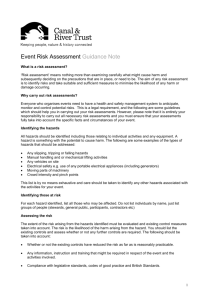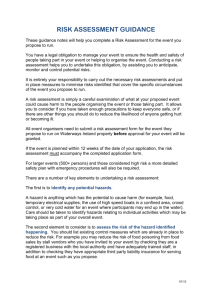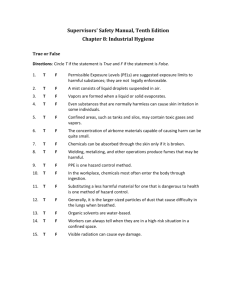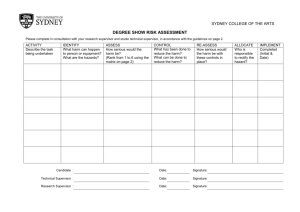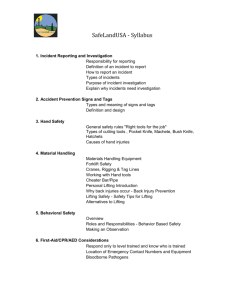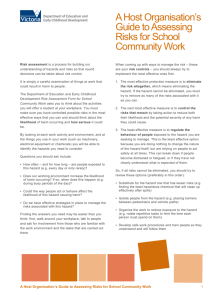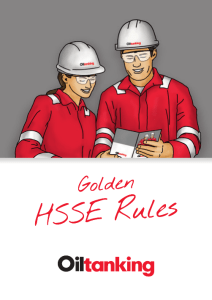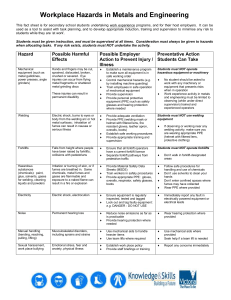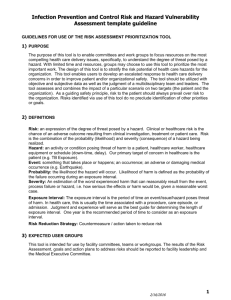General Risk Assessment Template - UTS
advertisement
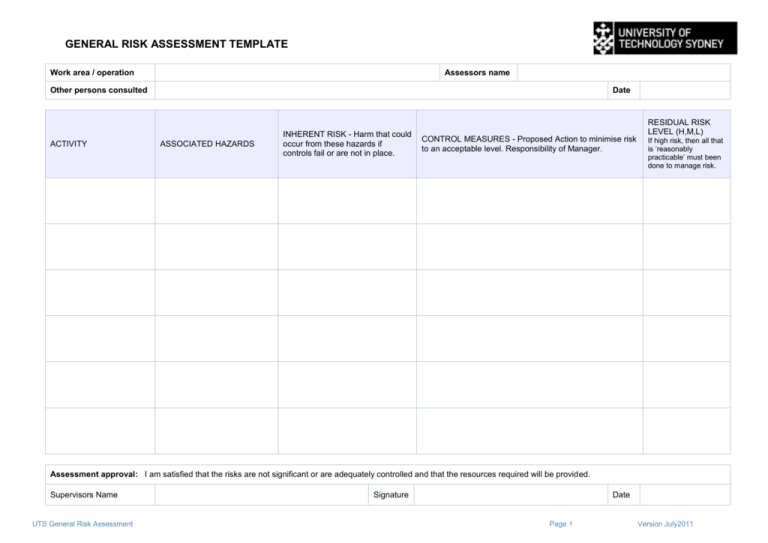
GENERAL RISK ASSESSMENT TEMPLATE Work area / operation Assessors name Other persons consulted ACTIVITY Date ASSOCIATED HAZARDS INHERENT RISK - Harm that could occur from these hazards if controls fail or are not in place. CONTROL MEASURES - Proposed Action to minimise risk to an acceptable level. Responsibility of Manager. RESIDUAL RISK LEVEL (H,M,L) If high risk, then all that is ‘reasonably practicable’ must been done to manage risk. Assessment approval: I am satisfied that the risks are not significant or are adequately controlled and that the resources required will be provided. Supervisors Name UTS General Risk Assessment Signature Date Page 1 Version July2011 Guidance notes for documenting General Risk Assessments ACTIVITY Describe here any hazardous activities related to the work area or operation. ASSOCIATED HAZARDS Plant & Equipment – noise, vibration, moving parts (crushing, friction, stab, cut, shear), pressure vessels, lifts/hoists/cranes, sharps Manual Handling – repetitive movements, lifting awkwardly, lifting heavy objects Work Environment – moving objects, extremes in temperature, isolation, work at height, allergies to animal bedding, dander and fluids People – potentially violent or volatile clients/interviewees Communicable Diseases – exposure to bodily fluids/infectious materials, animal bites and scratches, Environmental – emissions to atmosphere, discharge to soil and water bodies (including stormwater run-off), nuisance noise & odour Radiation (non-ionizing) – including lasers, microwaves or UV light Electrical – plug-in equipment used in ‘hostile’ work environment, exposed conductors, high voltage equipment Pathogens – dealings with pathogenic microorganisms such as bacteria, parasites, fungi or viruses GMOs – dealings with genetically modified organisms Cytotoxins – carcinogens, mutagens or teratogens Radiation (ionizing) – Ionizing radiation source such as radioactive substance or radionuclide, or irradiating apparatus Chemical – hazardous substances, dangerous goods, fumes, dust, compressed gas INHERENT RISK Provide details of the harm that could be caused to people or the environment if something goes wrong. For example: inhalation of fumes, laceration, injury to back, infection, burns to skin or eyes. Think about what could happen if controls fail or are not in place. CONTROL MEASURES This is proposed action to reduce risk to an acceptable level. Apply the “Hierarchy of Controls”, listed below, when deciding the best control measure to apply. Control types closer the top of the list are preferable. 1. ELIMINATE THE HAZARD. For example: use a different less dangerous piece of equipment, fix faulty machinery, use safer materials or chemicals 2. ISOLATE THE HAZARD FROM THE PEOPLE. Separate people from the danger. For example: use shielding, use lifting equipment or trolleys, remove dust or fumes with exhaust system, lock-out machinery. 3. CHANGE THE WAY THE JOB IS DONE. For example: change work practices, provide training, information and signs, write work procedures. 4. USE PERSONAL PROTECTIVE EQUIPMENT (PPE), noting specific PPE is required for each job. For example: respirator, hearing protection, gloves. Training and information is required for the use of PPE. RESIDUAL RISK LEVEL (H, M, L) Estimate risk taking into account the way the activity is run and control measures put in place. The level of risk can be determined by combining consequence and likelihood using the risk matrix from below. Residual risk should be reduced to a level acceptable by management. CONSEQUENCE OF HARM This is how bad it will be if something does go wrong i.e. the number of people that could be harmed, the severity of injury. INSIGNIFICANT – Non-injury incident. Minor effects on biological or physical environment. MINOR – Injury or ill health requiring first aid. Moderate, short-term effects but not affecting ecosystem functions. MODERATE – Injury or ill health requiring medical attention. Serious medium-term environmental effects. MAJOR – Injury or ill health requiring hospital admission. Very serious long term impairment of ecosystem functions. CATASTROPHIC – Fatality or permanent disabling injury. Very serious long term impairment of ecosystem functions. LIKELIHOOD OF HARM Chance of harm occurring is affected by the duration of the activity and its frequency; the number of people doing the activity and the level of exposure to the hazard. RARE – Heard of something like this occurring elsewhere. UNLIKELY – The event does occur somewhere from time to time. POSSIBLE – The event might occur once in your career. LIKELY – The event has occurred several times or more in your career. ALMOST CERTAIN – The event will occur on an annual basis. UTS General Risk Assessment CONSEQUENCES LIKELIHOOD Insignificant Minor Moderate Major Catastrophic Almost certain H H E E E Likely M H H E E Possible L M H E E Unlikely L L M H E Rare L L M H H From AS/NZS 4360: Risk Management.
